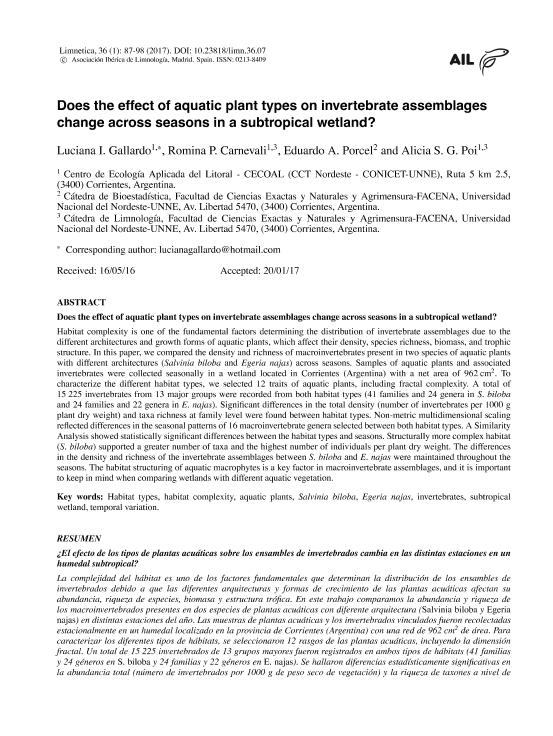Artículo
La complejidad del hábitat es uno de los factores fundamentales que determinan la distribución de los ensambles de invertebrados debido a que las diferentes arquitecturas y formas de crecimiento de las plantas acuáticas afectan su abundancia, riqueza de especies, biomasa y estructura trófica. En este trabajo comparamos la abundancia y riqueza de los macroinvertebrados presentes en dos especies de plantas acuáticas con diferente arquitectura (Salvinia biloba y Egeria najas) en distintas estaciones del año. Las muestras de plantas acuáticas y los invertebrados vinculados fueron recolectadas estacionalmente en un humedal localizado en la provincia de Corrientes (Argentina) con una red de 962 cm2 de área. Para caracterizar los diferentes tipos de hábitats, se seleccionaron 12 rasgos de las plantas acuáticas, incluyendo la dimensión fractal. Un total de 15 225 invertebrados de 13 grupos mayores fueron registrados en ambos tipos de hábitats (41 familias y 24 géneros en S. biloba y 24 familias y 22 géneros en E. najas). Se hallaron diferencias estadísticamente significativas en la abundancia total (número de invertebrados por 1000 g de peso seco de vegetación) y la riqueza de taxones a nivel de familias entre tipos de hábitats. El análisis de Escalamiento Multidimensional No Métrico (NMDS) mostró diferencias en los patrones estacionales de 16 géneros de macroinvertebrados seleccionados entre ambos tipos de hábitat. El análisis de Similaridad mostró diferencias estadísticamente significativas entre tipos de hábitat y estaciones. El hábitat que presentó mayor complejidad estructural (S. biloba) albergó mayor número de taxones y de individuos por peso seco de vegetación. Las diferencias en la abundancia y riqueza de las comunidades de invertebrados entre S. biloba y E. najas fueron mantenidas en las distintas estaciones. La estructuración del hábitat por parte de las macrófitas acuáticas es un factor clave para los ensambles de macroinvertebrados y necesita ser tenida en cuenta cuando se realizan comparaciones entre humedales con diferente vegetación acuática. Habitat complexity is one of the fundamental factors determining the distribution of invertebrate assemblages due to the different architectures and growth forms of aquatic plants, which affect their abundance, species richness, biomass, and trophic structure. In this paper, we compared the abundance and richness of macroinvertebrates associated with two species of aquatic plants with different architectures (Salvinia biloba and Egeria najas) across seasons. Samples of aquatic plants and associated invertebrates were collected seasonally in a wetland located in Corrientes (Argentina) with a net area of 962cm2. To characterize the different habitat types, we selected 12 traits of aquatic plants, including fractal complexity. A total of 15 225 invertebrates from 13 major groups were recorded from both habitat types (41 families and 24 genera in S. biloba and 24 families and 22 genera in E. najas). Significant differences in the total abundance (number of invertebrates per 1000 g plant dry weight) and taxa richness at family level were found between habitat types. Non-metric multidimensional scaling reflected differences in the seasonal patterns of 16 macroinvertebrate genera selected between both habitat types. A similarity analysis showed statistically significant differences between the habitat types and seasons. Structurally more complex habitat (S. biloba) supported a greater number of taxa and the highest number of individuals per plant dry weight. The differences in the abundance and richness of the invertebrate assemblages between S. biloba and E. najas were maintained throughout the seasons. The habitat structuring of aquatic macrophytes is a key factor in macroinvertebrate communities, and it is important to keep in mind when comparing wetlands with different aquatic vegetation.
Does the effect of aquatic plant types on invertebrate assemblages change across seasons in a subtropical wetland?
Título:
¿El efecto de los tipos de plantas acuáticas sobre los ensambles de invertebrados cambia en las distintas estaciones en un humedal subtropical?
Fecha de publicación:
05/2017
Editorial:
Asoc Espan Limnol-mislata
Revista:
Limnetica
ISSN:
0213-8409
Idioma:
Inglés
Tipo de recurso:
Artículo publicado
Clasificación temática:
Resumen
Archivos asociados
Licencia
Identificadores
Colecciones
Articulos(CECOAL)
Articulos de CENTRO DE ECOLOGIA APLICADA DEL LITORAL (I)
Articulos de CENTRO DE ECOLOGIA APLICADA DEL LITORAL (I)
Citación
Gallardo, Luciana Irene; Carnevali, Romina Patricia; Porcel, Eduardo A.; Poi, Alicia Susana G.; Does the effect of aquatic plant types on invertebrate assemblages change across seasons in a subtropical wetland?; Asoc Espan Limnol-mislata; Limnetica; 36; 1; 5-2017; 87-98
Compartir
Altmétricas




